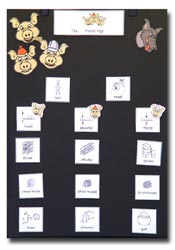Practical Guides
Storyboards
Storyboards can be used to develop children's attention and listening skills, story sequencing, vocabulary, oral language skills, independent writing and social interaction skills.
Storyboards:
- provide lots of visual interest
- promote good attention
- encourage children to be actively involved
- increase expressive language
- teach prediction skills
- help to develop sequencing through the use of visual clues
- increase confidence in using symbols in other areas
- provide a visual reference point for asking questions to check child's understanding
They may be used with whole class or small groups of children.
What is a Storyboard?
 Storyboarding is a way of group storytelling using visual prompts. As the story is told symbols or objects are used to help the group understand and remember the words.
Storyboarding is a way of group storytelling using visual prompts. As the story is told symbols or objects are used to help the group understand and remember the words.
A typical Story board will include:
- a set of symbols or images that support the key words in the story
- some illustrative pictures that set the scent or allow animation of the story - for example small dolls or other artefacts
- a board on which to place these items as the story unfolds.
The story may be told by the teacher to a group, but equally well, children can join in adding items to the board or even telling parts of the story themselves.
Storyboards | Using Storyboards | Making Storyboards | Activity Outcomes
